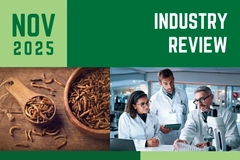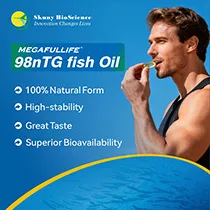
- Industry news
Industry news
- Category news
- Reports
- Key trends
- Multimedia
Multimedia
- Journal
- Events
- Suppliers
Suppliers
- Home
- Industry news
Industry news
- Category news
- Reports
- Key trends
- Multimedia
Multimedia
- Events
- Suppliers
Suppliers
Sustainable microalgae: Parry Nutraceuticals eyes spirulina’s potential in F&B markets following certification

After a two-year hiatus, India-based microalgae giant Parry Nutraceuticals is re-entering the European market with a fresh import license for its organic spirulina. This development comes as the F&B sector turns toward microalgae to reduce reliance on palm oil, animal-derived meats and conventional animal feed in times of climate change and supply chain disruptions.
Parry’s European business development manager, Sofia De Mendonça, tells Food Ingredients First that the EU import license is an opportunity for the company to “recover in a significant historical market, where our solutions continue to be valued by the most demanding brands.”
She also views this as a strategic move for the broader microalgae sector, where food manufacturers are trying to bring the ingredient into the mainstream.

“Our presence in Europe can consolidate the sustainable potential that microalgae have, not only within the supplements domain but also more and more, as we observe, within food and beverage applications.”
From supplements to F&B
Spirulina is commonly found in supplements but is gaining ground in F&B with the rise of plant-based diets and natural colors.
“Bakery, pastry and all kinds of oil-based food formulations can potentially have the presence of spirulina and chlorella within their recipes. Many so-called green smoothies are already trending in beverage applications.”
An example Mendonça shares is a recent collaboration with an ice cream brand to develop a lemon-chlorella flavor. This product enhanced the ice cream’s nutritional profile and gave it a unique texture and color, which became particularly popular among children.
Additionally, spirulina’s versatility allows it to be used in foods like pasta, pizza dough, cake dough, canned goods, and some specific frozen recipes, such as ice cream.
 Parry offers spirulina in tablet, powder and granular formats.Health and environment-conscious consumers are increasingly swapping high-emission foods with eco-friendlier options, resulting in the rise of plant-based and flexitarian diets.
Parry offers spirulina in tablet, powder and granular formats.Health and environment-conscious consumers are increasingly swapping high-emission foods with eco-friendlier options, resulting in the rise of plant-based and flexitarian diets.
While Mendonça notes that texture and taste can be challenging aspects for spirulina-forward F&B concepts, Parry’s R&D and technological innovation are addressing these concerns.
“We managed to improve the organoleptic profile of our spirulina biomass by preserving its cell structure — which is quite delicate — and avoiding the loss of some fatty acids and other compounds, which add nutritional and functional value to the spirulina powder,” she explains.
“This way, we optimized the process and ensured a pleasant but characteristic taste of the spirulina. The same thing was done for the chlorella differently. Regarding the textures, both spirulina and chlorella powder may be added to specific preparations, and the texture will certainly be affected. This is something which I would invite the food industry to study.”
Product versatility
While Parry offers spirulina in various forms, including granules and white-label tablets, the powdered format remains most popular among food manufacturers as it’s easier to incorporate into recipes.
“On the other hand, granules are a great alternative to be included in dairy products such as cheese and yogurt. It also has a fascinating visual effect in bakery and pastry recipes and cereal and cereal bar formulations,” Mendonça shares.
The company has developed a prototype with a milder flavor, explicitly designed for “organoleptic-sensitive” applications. This innovation responds to consumer expectations for natural, nutrient-rich, palatable ingredients.
While the milder prototype is different from the characteristic taste of spirulina, Mendonça thinks “microalgae are being more and more accepted not only in terms of their color — the end consumer knows it is a natural origin color — but also in terms of their characteristic flavor.”
Addressing consumer perceptions
 Parry Nutraceuticals has microalgae raceway ponds in south India (Image credit: Parry Nutraceuticals).Parry Nutraceuticals now holds the Naturland certification, which is believed to be more stringent than the EU organic status as it incorporates social responsibility into its compliance criteria.
Parry Nutraceuticals has microalgae raceway ponds in south India (Image credit: Parry Nutraceuticals).Parry Nutraceuticals now holds the Naturland certification, which is believed to be more stringent than the EU organic status as it incorporates social responsibility into its compliance criteria.
“We see this demanding Naturland certification as the cherry on the cake,” says Mendonça.
In addition to the regulatory nods, she says Parry’s cultivation practices hugely benefit from the optimal climate conditions of the south of India, where the microalgae are grown amid year-long sunlight.
However, despite holding two major certifications, consumer perceptions about the quality of microalgae produced in Asia can “indeed pose a challenge.”
Transparency in production practices, quality control and certifications remains crucial for the company to navigate these concerns.
“Our R&D and science projects are dedicated to understanding the real health and impact with which Parry’s spirulina and chlorella can have on the human body. This already differentiates us from the overall production players globally,” she concludes.












